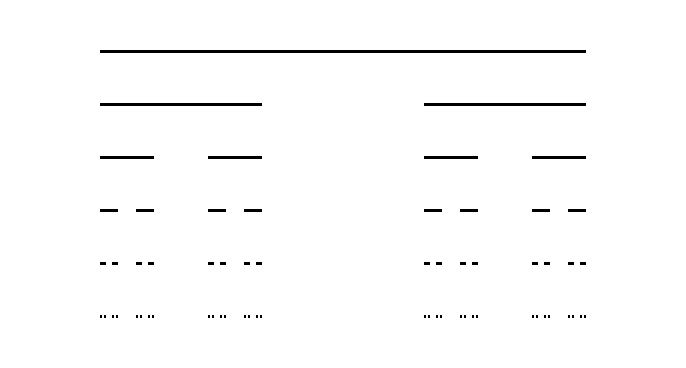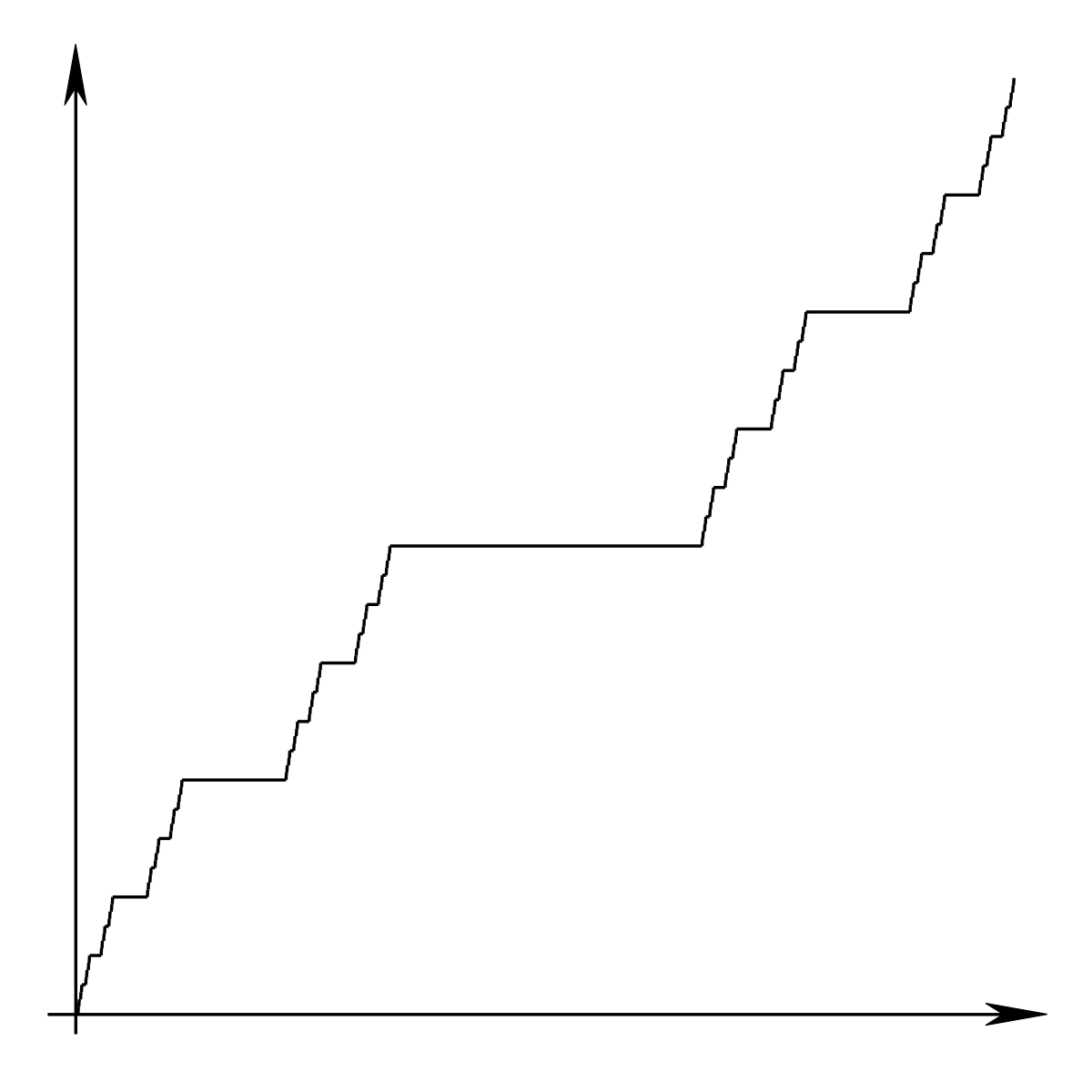Lebesgue Measurable Sets and Borel Measurable Sets
25 Feb 20251. Lebesgue Measure
From Carathéodory’s theorem, we can define a measure $m$ on $\mathbb{R}$ as follows.
-
Show that $\mathcal{A}_0 = \lbrace \cup^n_{k=1} (a_k, b_k] : a_k, b_k \in \mathbb{R}^\infty \rbrace $ is an algebra.
-
For $A \in \mathcal{A}_0$, show that the representation $A = \sqcup^n_{k=1} (a_k, b_k]$ is unique.
-
Define $\rho: \mathcal{A}_0 \to [0, \infty]$ as:
\[\rho(\sqcup^n_{k=1} (a_k, b_k]) = \sum^n_{k=1}(b_k - a_k)\]Show that $\rho$ is a premeasure.
-
Apply Carathéodory’s extension theorem to $\mathcal{A}_0, \rho$ to obtain the outer measure $m^\ast$.
-
Restrict the domain of $m^\ast$ to $m^\ast$-measurable sets to obtain $m$.
Since algebras are only closed under finite unions, steps 1, 2, and 3 are almost trivial. For the proofs of steps 4 and 5, see the related post.
Definition. The aforementioned $m$ is called the Lebesgue measure. Moreover, sets belonging to the domain of $m$ are called Lebesgue measurable.
The following facts follow readily from Carathéodory’s theorems.
Theorem.
- $m([a, b]) = m((a, b)) = m((a, b]) = m([a, b)) = b - a$
- When $A \subset \mathbb{R}$ is countable, $m(A) = 0$
Since the measure obtained by Carathéodory’s extension theorem is a complete measure, the following holds.
Theorem. $m$ is a complete measure.
Furthermore, since $\sigma(\mathcal{A}_0)$ is the Borel $\sigma$-algebra $\mathcal{B}$, it follows that:
Theorem. Borel measurable sets are Lebesgue measurable.
2. Sets That Are Lebesgue Measurable but Not Borel Measurable
Definition. Define the sequence of sets $\lbrace C_n \rbrace$ as follows:
\[\begin{gather} C_0 = [0, 1]\\ C_1 = I_0 \setminus (1/3, 2/3) \\ C_2 = I_1 \setminus \{ (1/9, 2/9) \cup (7/9, 8/9) \} \\ \vdots \end{gather}\]The Cantor set $C$ is defined as $\cap^\infty_{n = 0}C_n$.
Theorem.
- The Cantor set is uncountable.
- The Cantor set has Lebesgue measure 0.
Proof.
-
Elements belonging to the Cantor set are numbers whose ternary decimal expansion contains no digit 2 in any position. There are $2^\aleph_0$ such numbers, hence uncountable.
-
Since $m(C_n) = (2/3)^n$, we have $m(C) = \lim_{n \to infty} (2/3)^n = 0$. ■
Definition. Let $J_n$ denote the sets removed at each stage in defining the Cantor set. That is,
\[\begin{gather} J_1 = (1/3, 2/3) \\ J_2 = (1/9, 2/9) \cup (7/9, 8/9) \\ \vdots \end{gather}\]Define the sequence of functions as follows:
\[\begin{gather} \operatorname{dom} f_1 = J_1,\; f_1(x) = \frac{1}{2} \\\\ \operatorname{dom} f_2 = J_1 \cup J_2, \; f_2(x) = \begin{cases} 1/4 & x \in (1/9, 2/9) \\ 1/2 & x \in (1/3, 2/3) \\ 3/4 & x \in (7/9, 8/9) \end{cases} \\\\ \vdots \end{gather}\]Define $f: I \to I$ as follows:
\[f(x) = \inf \{ f_n(y) : y \geq x, y \in \mathrm{dom} f \}\]$f$ is called the Cantor function.
Theorem. The Cantor function is continuous.
Proof. Let $f$ be the Cantor function. Since $f$ is an increasing function, if $f$ has discontinuities, they would be jump discontinuities. Therefore, for some $\epsilon > 0$ and $y_0 \in I$, the interval $(y_0 - \epsilon, y_0 + \epsilon)$ would lie outside $\operatorname{im} f$. However, among the elements of $(y_0 - \epsilon, y_0 + \epsilon)$, there exists a number whose binary decimal expansion has finitely many digits. Such a number belongs to $\operatorname{im}f$, which is a contradiction. ■
Theorem. There exist sets that are Lebesgue measurable but not Borel measurable.
Proof.
Lemma. If $f: I \to I$ is an increasing function, then $f^{-1}$ maps Borel sets to Borel sets.
Proof of lemma. Let $\mathcal{A} = \lbrace S \subset I : f^{-1}(S) \in \mathcal{B} \rbrace $. It is trivial that $\mathcal{G} \subset \mathcal{A}$, where $\mathcal{G}$ is the collection of open sets of $I$. Moreover, it is trivial from properties of inverse functions that $\mathcal{A}$ is a $\sigma$-algebra. Therefore, $\mathcal{A} \supseteq \sigma(\mathcal{G}) = \mathcal{B}$.
Let $f$ be the Cantor function and define $F$ as follows:
\[F(x) =\inf \{y : f(y) \geq x \}\]$F$ is a strictly increasing function with $\operatorname{im} F = C$ (where $C$ is the Cantor set). Let $V$ be the Vitali set. Since $F[V]$ is contained in $C$, it is a null set and thus, is Lebesgue measurable by the completeness of Lebesgue measure. However, $F[V]$ is not Borel measurable. If it were Borel measurable, then since $F$ is strictly increasing (hence injective), $F^{-1}(F[V]) = V$ would have to be measurable. ■

